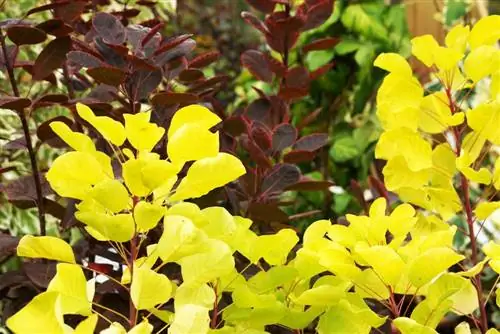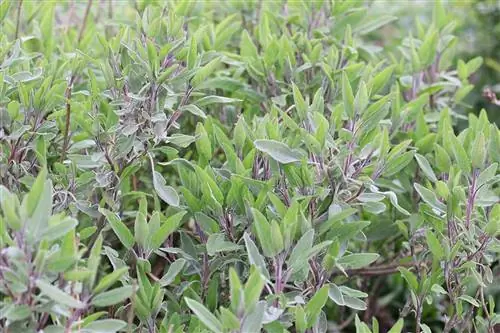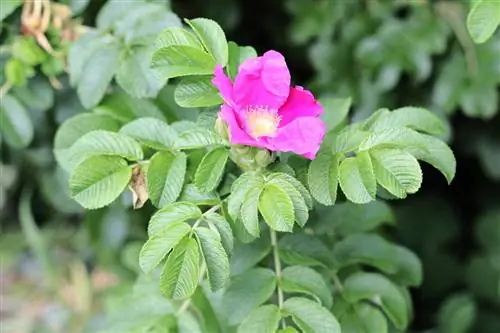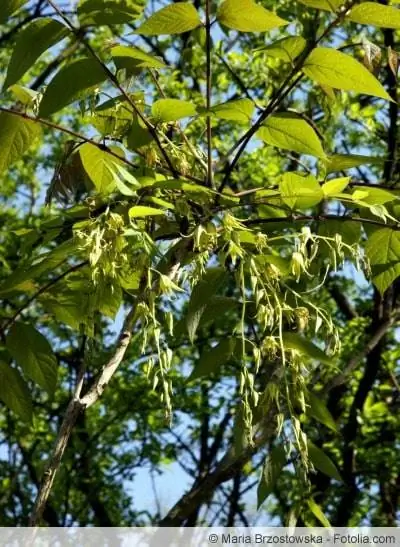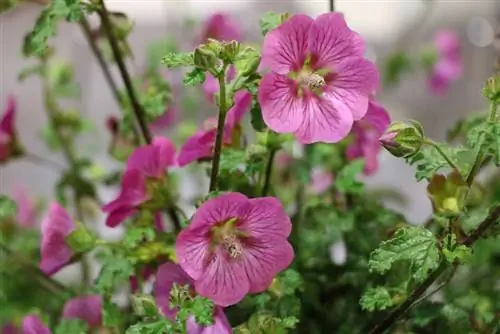- Author admin [email protected].
- Public 2023-12-17 03:39.
- Last modified 2025-06-01 06:48.
A regular cut is not absolutely necessary for the wig bush, but pruning measures can still make sense for various reasons.
The best time for pruning - when exactly do you cut?
The wig bush is generally not particularly sensitive to various types of pruning. Therefore, in principle, it does not cause much damage all year round if individual branches that are perceived as annoying are cut out or dead wood is removed. Nevertheless, there are also certain times that should be used for more extensive cutting measures. Since the wounds of a wig bush can “bleed” relatively heavily when cut in late spring or summer, if possible, radical pruning with many large areas of wounds should not be carried out during these periods. Therefore, the following tips apply to pruning:
- smaller pruning can be done all year round
- If a wig bush is radically shortened, the time when the sap is dormant between late autumn and early spring should be used
- in spring: cut as far as possible before new growth appears
- Pruning after flowering: unusual due to the decorative fruit clusters and foliage color
- late pruning before the first snow is possible without any problems
Reasons for pruning
If there is enough space on your property, you can let the wig bush grow into an easy-care garden plant without annual pruning. However, there can certainly be situations in which pruning makes sense:
- when there is a lack of space in the garden
- for neighborly or legal reasons (hedge height, shadows, etc.)
- for rejuvenating older specimens
- for using the fruit heads as a decorative object
- to prevent the seeds from spreading in the garden
- to save ailing plants with a care cut
- to achieve a specific growth habit through topiary
Wig bushes are generally very suitable for training into certain shapes, which then require very little pruning effort over the years. The various subspecies of the wig bush are similarly uncomplicated when it comes to maintaining compact growth forms for green roofs or when used as a hedge plant. If, on the other hand, you want to cut to rejuvenate an old specimen or to fight a disease, then the pruning can be radically comprehensive. In comparison, the interventions to extract the fruit heads as a decorative object or to preventively remove them for practical reasons seem more like temporary cosmetic measures.
Proceed step by step when pruning
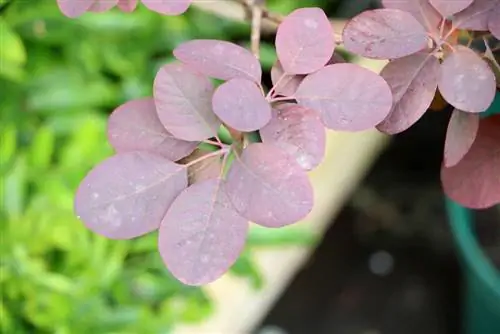
The most important thing when pruning plants is a well-thought-out procedure. Ideally, you should follow the following list:
- Choosing the right time for cutting: when exactly do you cut?
- Planning the best cut variant: radical or cautious?
- Preparation of necessary tools
- Cutting the plant in a multi-step process until the desired shape is achieved
- Supply of larger interfaces with products for tree wound care
- pay special attention to plant care in the first few weeks after cutting
- Increased watering interval when pruning in spring or summer: when is more water needed?
- Disposal of cutting material (outside the garden in case of fungal diseases or mildew)
Are there different pruning needs depending on the subspecies?
In principle, a red wig bush, for example, has similar care and location requirements as the common wig bush and the yellow-leaved wig bush. However, the need for pruning can of course be influenced by how much growth a particular subspecies achieves annually at its location.
If, for example, the widespread common wig bush was planted correctly and cared for properly in the first few years of life, annual growth rates of around 40 centimeters can certainly be expected. Therefore, a tip: Regardless of the color of the leaves, pruning measures should always take place between autumn and spring, when there is as little loss of plant sap at the interfaces as possible.
Useful garden tools for pruning these shrubs
For pruning with a caring character and as little he alth stress as possible for the respective plant, suitable and well-maintained garden tools should be used. The following tools may come in handy when trimming the wig bushes:
- Gloves
- Pruning Shears
- Saw
- Planting scissors
- Hedge trimmer
Gloves may not be tools in themselves, but they can provide effective protection from the ingredients in wig bushes for relatively sensitive people and people suffering from allergies. They also protect against discoloration caused by the leaf material and wood, which was and is specifically used as a dye in some varieties. Depending on the thickness of the twigs and branches to be cut, planting shears, loppers or saws are used. The sharper and cleaner these tools are, the less impact the cutting has on the he alth of your plants. If you have already trained your wig bush to a certain shape and just want to shorten the annual growth, a hedge trimmer can usually provide good and, above all, quick service.
Note: When using hedge trimmers to cut in a time-efficient manner, a lot of leaves are usually cut and cut up. These “cutting inaccuracies” that are hard to avoid should be repaired by hand as soon as possible using planting scissors, otherwise the damaged leaves can impair the appearance of the plant when they are wilted.
The different types of pruning
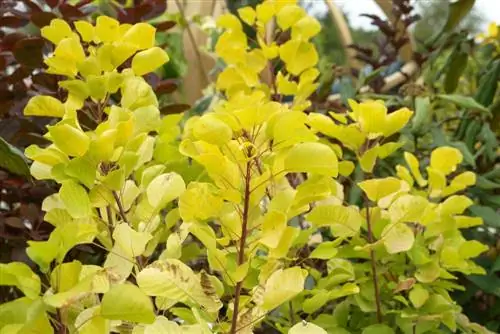
When pruning plants in general and also when caring for wig bushes, a distinction is made between different types of pruning measures, which are differentiated according to their respective objectives and procedures:
- Topiary
- Rejuvenation or maintenance cut
- Radical cut
- Cutting the inflorescences or fruit heads
The topiary
When cutting topiary, you should note that very young specimens of the wig bush should not be cut at all. Otherwise, the plants, which are somewhat more sensitive in their youth, have no chance of developing a he althy and strong plant base and there may even be problems with the frost tolerance of the otherwise relatively uncomplicated plants in this respect. Basically, there are hardly any limits to your imagination when it comes to topiary and over the years you can train the wig bush into a rough hedge or spherical shape through targeted cuts.
It looks even more impressive if you cut off each year's fresh offspring just above the thickened main branches. Over time, rounded trunk shapes emerge at the top, as can often be seen in regularly maintained plane trees in urban gardens and parks. In general, a maximum of a third of the plant mass should be cut off when regularly carried out topiary.
Force a certain shrub shape with a rejuvenation or care cut
The decision as to when to cut a wig bush is often related to a certain size and the corresponding conditions in the garden. In this sense, the above-mentioned pruning of the wig bush is generally aimed at a more compact shape, which is why sprawling and outward-facing branches are boldly removed. In order to preserve an aging specimen, it can also make sense to specifically thin out the “treetop” of the wig bush that has grown into itself with a rejuvenation and care cut.
This applies, for example, to the red wig bush or to particularly shady and moist locations. Similar to certain types of fruit trees, care should be taken to ensure that the plant material is permeable to air in order to prevent increased susceptibility to powdery mildew as a result of leaf material that dries poorly. To do this, preferably cut out the particularly angled twigs and branches from the inside of the shrub structure.
The Radical Cut
Radical pruning refers to care measures for the wig bush in which at least two thirds of all twigs and branches and, if necessary, some of the roots are removed. This cut is often used at a time when either an illness requires it or the necessary cut has been overlooked for many years. Despite the courageous removal of numerous branches, even with this type of pruning, the future desired shrub shape should be taken into account and some leaf mass should always be left (except in the case of fungal diseases). Particularly in the case of radical cuts, attention should be paid to the necessity of the measure on the one hand, but also to the right time and a well-thought-out procedure on the other. In order to keep the additional stress on the affected plant as low as possible, a period between late autumn and spring (before new growth) should be chosen for radical pruning.
Tip
A red wig bush (Cotinus coggygria 'Royal Purple') is generally more susceptible to potential powdery mildew infestation than is the case with the common wig bush. If cutting back radically affects the growth habit in order to save an infected specimen, the cutting material should then be disposed of and not end up in your own compost heap. In addition, immediately after a powdery mildew infestation occurs, no other plants known to be susceptible to powdery mildew diseases may be planted in the same location for a period of several years. If radical pruning is carried out to combat disease or fungus, then the affected roots should also be shortened so that fresh growth is stimulated.
Cutting the flowers and fruit heads
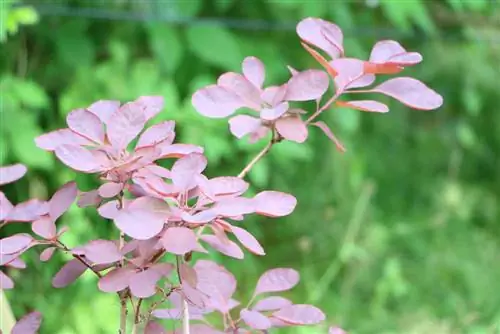
From a plant he alth perspective, there is actually no reason to cut off the flowers of the wig bush once they have faded. While cutting the wilting flower pile is recommended when caring for many balcony flowers in order to save the plants the effort of producing seeds, with the seed heads of the wig bush you would be depriving yourself of one of the most decorative aspects of this plant species. In addition, although it is true that this means an “expenditure of effort” for every plant, fruit formation is not really that important for the fast-growing wig bushes. Using the inflorescences or the extremely magnificent fruit clusters as decorative objects is in itself very uncomplicated: These can easily be cut off in autumn if necessary and placed in the house.
Tip:
Cut off the ripe seed heads before winter to use them as long-lasting parts in dry bouquets and arrangements. Be careful not to miss the right time to do this in late autumn. Otherwise, the fruit clusters could have already developed mold in particularly wet weather.
How to make the cuts correctly when pruning
Due to the sparse growth of this shrub with its alternate leaves, the exact intersection points when shortening the individual shoots can be set to a certain extent “by feel”. For the sake of appearance, however, it is advisable to make the cuts on the thinner branches just a little above a branch. For thicker branches or pieces of trunk, you should be careful not to leave an absolutely horizontal cut surface. Rainwater would constantly accumulate on such a thing, which could make wound healing more difficult and pose a risk to plant he alth.
A difficult case when propagating cuttings
If you miss the cuttings in this list, please note the following: Wig bushes are only very conditionally suitable for propagation by cuttings. Sowing seeds and growing so-called lowering plants promise more success. To do this, longer side shoots near the ground are covered with a little soil and only separated from the mother plant as offshoots after roots have formed. If possible, save yourself the tedious attempt to grow young plants of the wig bush from cuttings. Instead of allowing cuttings to grow under complex conditions and with special rooting hormones, you can grow young plants from sinkers much more easily.
Care needs immediately after the cut
Particularly after very severe cutting measures, attention should be paid to sufficient water supply and to wound healing at the incision sites. The latter is particularly true if a red wig bush grows in a location that is not too sunny, as the red version of the wig bush is generally more susceptible to powdery mildew and various fungal diseases. Accordingly, the plants should be watered sufficiently immediately after cutting, but the interfaces should be kept as dry as possible.
The flower after the cut
In general, you have to assume that a wig tree that has been cut back very heavily will no longer produce any flowers in the same year and therefore will not produce any decorative fruit sets. The situation is different when individual large branches are removed as part of a rejuvenation cut or for topiary pruning: here, as a rule, enough flower buds are retained for a decorative flower.
Where do I put the clippings?
You can compost the cut twigs and branches of wig bushes as normal or dispose of them using systems such as the organic waste bin or the local recycling center. As already stated above, it is not worth trying to propagate by cuttings (which is only successful under complicated conditions). The branches resulting from radical pruning can reach a considerable thickness and can therefore be processed into firewood or chopped into litter. Cuttings should not be composted in your own garden if they are the remains of plants that have died from powdery mildew or the infamous verticillium wilt.

